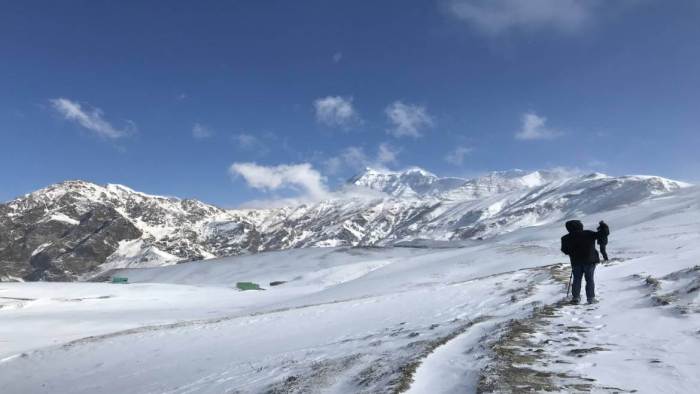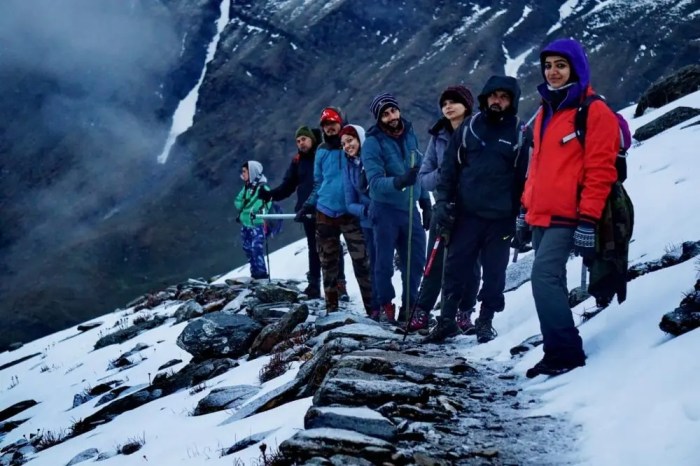
Embark on a thrilling journey to the world’s most breathtaking high-altitude trekking destinations. Get ready to conquer the heights, face unique challenges, and immerse yourself in the beauty of remote mountain areas. Let’s dive in!
High-Altitude Trekking Destinations

High-altitude trekking destinations offer breathtaking views and challenging terrains for adventurous hikers. Here are the top 5 high-altitude trekking destinations worldwide:
1. Everest Base Camp, Nepal
- Located at an elevation of 5,364 meters, this iconic trek offers stunning views of the world’s highest peak, Mount Everest.
- Trekkers will experience high altitudes, extreme weather conditions, and rugged terrain along the way.
2. Annapurna Circuit, Nepal
- This trek takes hikers around the Annapurna Massif, reaching altitudes of over 5,416 meters at Thorong La Pass.
- The challenges include altitude sickness, unpredictable weather, and long days of trekking through diverse landscapes.
3. Inca Trail, Peru
- One of the most famous treks in the world, the Inca Trail leads to the ancient ruins of Machu Picchu at an altitude of 2,430 meters.
- Trekkers must acclimatize to the high altitude and navigate steep steps and narrow paths along the way.
4. Kilimanjaro, Tanzania
- Mount Kilimanjaro stands at 5,895 meters and is Africa’s highest peak, attracting trekkers from around the globe.
- The trek presents challenges such as altitude sickness, drastic weather changes, and physically demanding terrain.
5. Mont Blanc, France
- This trek around the Mont Blanc Massif offers stunning alpine scenery and reaches heights of up to 4,810 meters at the summit.
- Trekkers will encounter high altitudes, glacier crossings, and rugged mountain paths during the journey.
Unique Challenges Faced by Trekkers in High-Altitude Environments
- Trekkers may experience symptoms of altitude sickness, such as headaches, nausea, and fatigue, due to reduced oxygen levels at high altitudes.
- Extreme weather conditions, including snow, wind, and sudden temperature changes, can pose risks to trekkers in high-altitude environments.
- Navigating steep and rocky terrain at high altitudes requires physical endurance, proper gear, and careful footing to prevent accidents.
Importance of Acclimatization when Trekking at High Altitudes
- Acclimatization allows the body to adjust to lower oxygen levels gradually, reducing the risk of altitude sickness and improving overall trekking performance.
- Trekkers should schedule rest days at higher altitudes to acclimatize properly and hydrate adequately to prevent dehydration at high altitudes.
- Slow and steady ascent rates help trekkers acclimatize effectively and reduce the likelihood of experiencing severe altitude-related illnesses.
Festival Travel
High-altitude trekking destinations not only offer breathtaking views and challenging trails but also host vibrant festivals that add another layer of cultural richness to the experience. These festivals are a major draw for travelers looking to immerse themselves in the local traditions and celebrations.Exploring the cultural significance of festivals celebrated in mountainous regions reveals a deep connection between the people and their environment.
Many of these festivals are rooted in ancient traditions, celebrating harvests, honoring deities, or marking important historical events. The mountainous terrain adds a unique backdrop to these celebrations, creating a mystical and awe-inspiring atmosphere.
Traditional Celebrations in High-Altitude Trekking Destinations
- Diwali in the Himalayas: Diwali, the festival of lights, is celebrated with great fervor in the Himalayan region. The mountains are illuminated with colorful lights and diyas, creating a mesmerizing sight for trekkers.
- Lhosar in Nepal: Lhosar, the Tibetan New Year, is a joyous occasion celebrated by the Sherpa and Tibetan communities in Nepal. Festivities include traditional dances, music, and feasting, making it a vibrant cultural experience for trekkers.
- Losar in Ladakh: Losar, the Ladakhi New Year, is another important festival celebrated in the high-altitude region of Ladakh. Colorful masked dances, traditional music, and elaborate rituals make this festival a must-see for cultural enthusiasts.
Mountain Trekking

When it comes to mountain trekking, the experience can vary significantly depending on the altitude of the terrain. Trekking in high-altitude mountains presents a unique set of challenges and rewards compared to lower-altitude terrains. Let’s explore the differences and similarities in these trekking experiences.
High-Altitude Mountains vs. Lower-Altitude Terrains
- High-Altitude Mountains:
- Thinner air and lower oxygen levels can lead to altitude sickness, requiring acclimatization periods.
- Extreme weather conditions, such as sudden storms and temperature fluctuations, pose additional risks.
- Breathtaking panoramic views and a sense of accomplishment from conquering higher peaks.
- Lower-Altitude Terrains:
- More oxygen-rich air makes breathing easier and reduces the risk of altitude-related illnesses.
- Milder weather conditions and less extreme terrain can make trekking more comfortable for beginners.
- Scenic landscapes and diverse flora and fauna to explore at a leisurely pace.
Gear and Equipment for Mountain Trekking Expeditions
- Sturdy hiking boots with ankle support to navigate rough and uneven terrain.
- Layered clothing to adapt to changing weather conditions and maintain body temperature.
- Trekking poles for stability and balance on steep ascents and descents.
- High-quality backpack with essentials like water, snacks, first aid kit, and navigation tools.
- Sleeping bag and tent for overnight stays in remote mountain areas.
Tips for Staying Safe and Healthy While Trekking in Remote Mountain Areas
- Stay hydrated and consume high-energy snacks to maintain stamina and prevent altitude sickness.
- Follow a gradual ascent schedule to allow your body to acclimatize to higher altitudes.
- Be prepared for changing weather conditions by carrying waterproof gear and extra layers.
- Inform someone about your trekking itinerary and expected return time for safety purposes.
- Respect the environment by following Leave No Trace principles and preserving the natural beauty of mountain landscapes.
Mountain Retreats
Mountain retreats in high-altitude locations offer a unique and peaceful escape for travelers seeking a serene environment amidst stunning natural surroundings. These retreats provide a range of amenities and services to ensure a comfortable and relaxing stay for guests.
Amenities and Services Offered
- Cozy accommodations with breathtaking views of the surrounding mountains and valleys.
- Healthy and delicious meals prepared with locally sourced ingredients.
- Guided nature walks and hiking excursions to explore the surrounding wilderness.
- Yoga and meditation classes to rejuvenate the mind and body.
- Spa facilities offering massages and wellness treatments for relaxation.
Benefits of Choosing a Mountain Retreat
- Escape from the hustle and bustle of city life and immerse yourself in the tranquility of nature.
- Opportunity to disconnect from technology and reconnect with yourself and the natural world.
- Personalized service and attention to detail to ensure a memorable and relaxing stay.
- Unique cultural experiences and interactions with local communities in remote mountain regions.
- Health benefits of being at high altitude, such as improved circulation and increased oxygen levels.
Popular Mountain Retreat Destinations
- Aspen, Colorado: Known for its luxurious mountain resorts and world-class skiing.
- Swiss Alps, Switzerland: Iconic mountain retreats offering stunning alpine views and outdoor activities.
- Himalayas, Nepal: Serene retreats nestled in the foothills of the world’s highest mountains.
- Patagonia, Argentina: Remote retreats surrounded by pristine wilderness and rugged landscapes.
- Canadian Rockies, Canada: Charming mountain lodges with access to hiking trails and wildlife viewing.
Wildlife Holidays
Exploring high-altitude treks not only offers breathtaking views but also the opportunity to witness a variety of wildlife species in their natural habitat.
Encountering Diverse Wildlife
During high-altitude treks, hikers may come across an array of wildlife such as snow leopards, Himalayan blue sheep, yaks, musk deer, and various species of birds including eagles and vultures.
Conservation Efforts
Conservation efforts are crucial in protecting the wildlife in mountainous regions. Organizations and national parks work tirelessly to preserve the natural habitats of these species and prevent illegal poaching and habitat destruction.
Experiences with Wildlife
- One memorable encounter while trekking in the Himalayas was spotting a majestic snow leopard from a distance, camouflaged against the snowy landscape.
- Another thrilling experience was witnessing a herd of Himalayan blue sheep gracefully navigating the rugged terrain.
- Listening to the echoing call of a Himalayan monal, a colorful bird native to the region, added a magical element to the trek.
Ending Remarks
From the challenges of high altitudes to encounters with diverse wildlife, high-altitude trekking destinations offer a unique and unforgettable experience for adventure seekers. Start planning your next expedition to these stunning locations and create memories that will last a lifetime. Happy trekking!
Commonly Asked Questions
What are the top 5 high-altitude trekking destinations worldwide?
The top 5 high-altitude trekking destinations include the Himalayas, Andes, Alps, Rockies, and Karakoram Range.
Why is acclimatization important when trekking at high altitudes?
Acclimatization is crucial to allow your body to adjust to lower oxygen levels, reducing the risk of altitude sickness.
What gear and equipment are needed for mountain trekking expeditions?
Essential gear includes sturdy hiking boots, layers of clothing, a reliable backpack, trekking poles, a sleeping bag, and a first aid kit.
What amenities and services are offered at mountain retreats in high-altitude locations?
Mountain retreats often provide comfortable lodging, meals, guided treks, and relaxation options like spa services or yoga classes.
How can travelers stay safe and healthy while trekking in remote mountain areas?
Travelers should stay hydrated, pace themselves, follow safety guidelines, and be prepared for weather changes to ensure a safe trekking experience.





